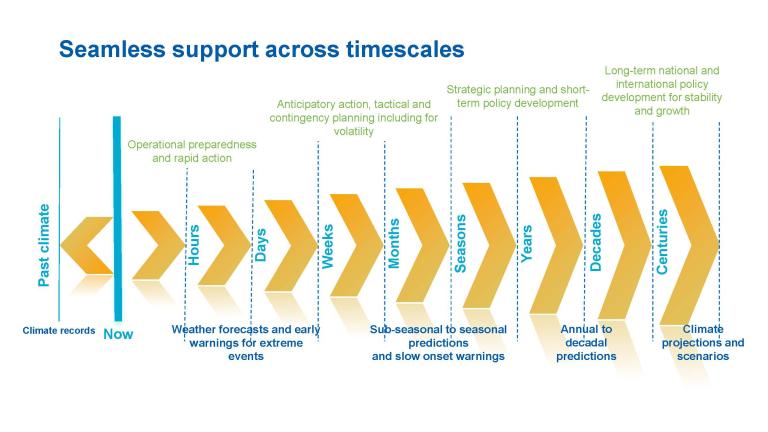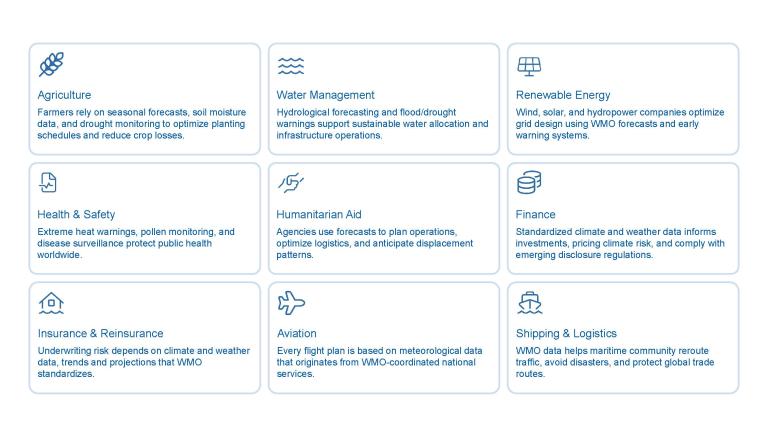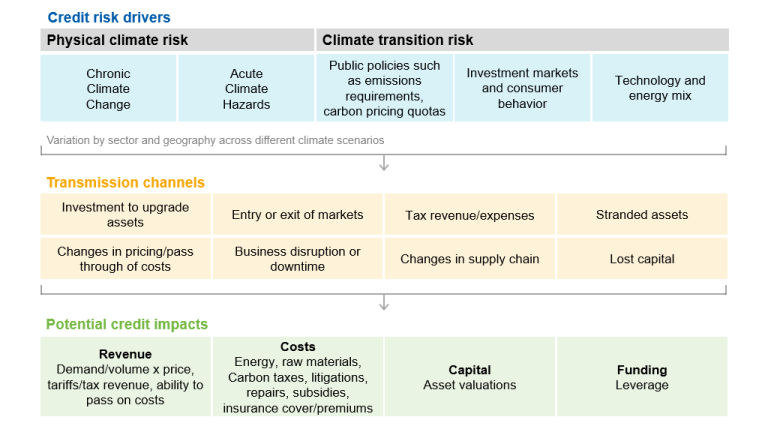WMO data has capacitated the creation of trillions in economic value
WMO was founded, and continues to be mandated, to avoid the "tragedy of the commons" - the notion that unfettered access to a finite and valuable resource will lead to over-exploitation, degradation and depletion. WMO oversees the collection and exchange of Earth systems data - weather, climate and water data - and the development of associated information services as global public goods. In the context of climate change, the demand for these public services from the many sectors impacted by weather and climate hazards - from architects and builders to insurance companies, the aviation and shipping industry and food and health service providers - has never been higher. WMO data has capacitated the creation of trillions in economic value by hedge funds analysing climate trends, by agriculture platforms optimizing yields and by reinsurance companies managing catastrophic risk.
Widely used consumer and business-to-business platforms and applications ultimately all rely on data originating from WMO-coordinated global, regional and national services. Most companies do not collect data themselves at scale - they ingest, repackage, sometimes model and visualize public sector information. Without continued investment in the global observing infrastructure and data standards that WMO coordinates, these services would degrade or collapse. The private sector, from investment managers to mobile weather application providers, depends on the integrity and availability of this global public infrastructure. Businesses rely on WMO upstream data services, not just for consumer information, but for billions in operational decisions, risk modelling and supply chain management.
Scaling up investment across the full weather, climate and water services value chain - from observations and data management to forecasting, early warnings and sector-tailored information services - will be critical to the continued success of WMO and its service to society.
The Tragedy of the Horizon
Ten years ago, Mark Carney, the then Governor of the Bank of England who is now Prime Minister of Canada, delivered a speech entitled Breaking the Tragedy of the Horizon - climate change and financial stability . Carney observed that "shifts in our climate bring potentially profound implications for insurers, financial stability and the economy" and "the challenges currently posed by climate change pale in significance compared with what might come. The far-sighted amongst you are anticipating broader global impacts on property, migration and political stability, as well as food and water security."
This "Tragedy of the Horizon" recognized that while climate change impacts will unfold over decades, economic and financial actors think in much shorter time frames, from days and months to a few years and often maximum one decade. Without science identifying critical impacts that will be felt during these shorter timescales, there is little immediate incentive for decision-makers to act decisively, possibly leading to "a collective failure to address climate risks early enough, despite knowing that delaying action will make the costs of adaptation and mitigation much higher later on."
The catastrophic impacts of climate change will be felt beyond the traditional horizons of most actors - beyond the business cycle, the political cycle, and the horizon of technocratic authorities. … The horizon for monetary policy extends out to 2 to 3 years. For financial stability it is a bit longer, but typically only to the outer boundaries of the credit cycle - about a decade. In other words, once climate change becomes a defining issue for financial stability, it may already be too late. - Mark Carney, 2015

Bridging the horizon
Carney concluded his 2015 speech by calling for enhanced risk management and planning across timescales, "with better information as a foundation, we can build a virtuous circle of better understanding of tomorrow's risks, better pricing for investors, better decisions by policymakers, and a smoother transition to a lower-carbon economy. By managing what gets measured, we can break the Tragedy of the Horizon."
WMO data is critical to sound decision-making to resolve this "tragedy". As the Organization that oversees the - often invisible - global public infrastructure that powers weather, water and climate decision-support systems, WMO coordinates one of the most expansive and trusted expert networks in the United Nations system. The Organization plays a central convening role, harmonizing global standards and scientific advances to improve climate resilience. Its unique position in the United Nations system allows it to engage countries, companies and communities at the global, regional and local levels.

Climate risk and economic instability
Gross domestic product (GDP) is often used to assess a country's economic status. However, GDP does not capture the detailed ways in which climate change disrupts economies and exposes financial fragilities. It does not reflect the depreciation of capital following extreme events, hidden costs like biodiversity loss and health impacts, or the persistence of damages over time. Nor does it capture how climate shocks cascade into business disruption, supply chain breakdowns, stranded assets and shifts in market valuation. For financial systems, this creates a critical blind spot: the true risks of climate change cannot be seen if analysis is limited to GDP.1
Physical risks from climate change directly undermine the stability of the financial system through both extreme events and gradual shifts in climate patterns.2 Increasingly extreme and frequent weather events heighten insurance risk, eroding asset values and reducing the insurability of property and operations.3 As insurability weakens, households and businesses lose the ability to transfer risk, fundamentally threatening the sustainability of credit, mortgages and long-term investment.
The insurance sector has long been the "canary in the coalmine" for climate impacts and was among the first to identify the threat.4 Munich Re and other insurers were already highlighting growing climate risks in the 1970s.5 In 2017, AXA Chief Executive Officer Thomas Buberl warned that a 4 °C warmer world would be uninsurable.6 This year, Allianz cautioned of a looming climate-induced credit crunch, threatening the very foundation of the financial sector, stressing that the economic value of entire regions could disappear from financial ledgers: "Markets will reprice, rapidly and brutally. This is what a climate-driven market failure looks like."7
Climate shocks and related policy shifts8 trigger cascading impacts through "transmission channels". For example, climate-driven asset upgrades, stranded assets, business downtimes and disrupted supply chains ultimately translate into reduced revenues, higher operating costs and asset revaluations, leading to reduced creditworthiness (Figure 3). However, as highlighted by Standard & Poor's (S&P), a global credit rating and financial intelligence company, "these channels exist in a world where companies and countries can adapt and respond to evolving climate-related risks."9

Climate change can affect the entire economy and financial system through these transmission channels (Figure 4). With climate risk exposures of around 60% in advanced economies and 30% in emerging markets, shocks can be transmitted through credit, market, liquidity and reputational channels, amplifying systemic financial instability. Between 22% and 45% of insurers' general account assets are climate-related, and when combined with equities, corporate bonds, and loans and mortgages, the share ranges from about 47% to 59% of total assets.10
WMO's global data systems are indispensable to manage these economic and financial risks. Its standardized and interoperable data streams form the backbone of high-frequency financial models that rely on real-time weather data to forecast immediate market risks - enabling algorithms to react to even small, frequent changes in conditions. At the same time, WMO's long-term climate datasets, predictions and projections underpin strategic decisions on investment, asset valuation and resilience planning, ensuring that markets can account for both short-term shocks and structural climate trends.
By anchoring climate risk analytics in authoritative, globally consistent information, WMO allows regulators and investors to measure how climate risks truly materialize across markets and sectors. Its observing networks, data exchange standards and research-to-operations pipeline are not peripheral services - they are the infrastructure of financial resilience.

Investment climate risk management
This foundation is already shaping market activity. In 2025, Bloomberg reported a sharp rise in hedge fund activity driven by weather data, as firms increasingly integrate advanced climate and weather modelling into trading strategies for energy and soft commodities.11 In private wealth management, advisors are beginning to integrate WMO-based risk data into client portfolios, while insurers and corporate risk managers use it to assess operational exposure to heatwaves, hurricanes, floods and other climate-driven threats. These are no longer marginal concerns - climate risk is now a material driver of asset performance.
Institutional investors are also moving rapidly in this direction. The One Planet Sovereign Wealth Fund (OPSWF) Network - whose members manage more than US$ 46 trillion in assets - has committed to promote long-term value, sustainable market outcomes and to address climate risks in their management of large, long-term and diversified asset pools. OPSWF members are working to harmonize disclosure practices and encourage stakeholders to release more consistent climaterelated data. Their collective actions underscore how the largest long-term asset owners are reshaping investment strategies around climate intelligence.12 The Network stresses that "the lack of climate data is a first principles problem: without robust climate data, it is impossible to take meaningful and informed investment decisions in relation to climate considerations. Furthermore, all market participants and stakeholders can benefit from the improved decision-making, transparency and insight that comes with stronger data quality."13
Integrating climate risk in financial regulations
Financial regulators are likewise embedding climate considerations into their oversight of systemic stability. According to the Network for Greening the Financial System (NGFS), both physical and transition risks could have systematic consequences for the global economy. Contagion effects - such as fire-sales, sovereign credit downgrades or bank leveraging - could amplify shocks if reliable data is lacking. A key barrier to assessing climate-related exposures is the availability of granular data to support bottom-up, quantitative analysis.14
NGFS, which represents over 130 central banks and supervisors, has developed climate scenarios that integrate physical risks such as floods, heatwaves, and droughts with transition risks like carbon pricing and energy system change, linking them to macro-financial outcomes.15 These scenarios have become a global reference point for climate stress testing and stability analysis. Yet, the NGFS itself underscores persistent gaps - including limited coverage of acute hazards, tipping points and data granularity - that constrain their precision.16
Beyond systemic oversight, WMO's data is also central to the growing web of corporate disclosure obligations. As of 2024, 30 jurisdictions, representing approximately 57% of GDP and more than 40% of global market capitalization, have decided to use, or are taking steps, to introduce consistent sustainability disclosure standards17 in their legal or regulatory frameworks.18 WMO data is critical for companies to adhere to these disclosure requirements, particularly in reporting climate-related physical risks, opportunities and capital deployment under the climate-related standard.19
Global security considerations
In a similar way to economic stability, many of the risks to global security are impacted by climate change. "National security leaders must refine and expand our understanding of 'security' to encompass climate-related risks...extreme weather is not an isolated issue confined to environmental discussions. It is a powerful driver or exacerbator of instability, poverty, conflict and, ultimately, migration."20
Climate volatility does not act in isolation, but as a risk multiplier that deepens existing fragilities and erodes stability. The international security community has increasingly recognized this reality. The International Military Council on Climate and Security (IMCCS) frames climate change as a global security concern requiring prevention, preparedness and cooperation to manage the risks.21 The Berlin Climate and Security Conference (BCSC) highlights that climate risks must be addressed across the full spectrum of conflict prevention, peacekeeping and post-conflict reconstruction.22 Recent BCSC discussions have further drawn attention to issues such as resource competition, food and water insecurity, and the security implications of the global energy transition, underscoring that climate threats are inseparable from the wider peace and security agenda.23
WMO is critical for global stability.
Against this backdrop, WMO provides decisionmakers with the data and foresight to manage cascading risks like food price shocks, migration surges, energy disruptions and public health emergencies, all of which can erode national, regional and global cohesion and stability. By equipping nations and markets with the tools to anticipate shocks before they escalate into crises, WMO is helping to protect lives and livelihoods and reinforcing the foundations of peace and stability in an increasingly volatile world.
WMO leadership in resilience, including its global drive to expand early warning systems, has been transformative, cutting disaster mortality dramatically over the past 50 years. Yet the true value of resilience goes far beyond saving lives - it delivers a range of socioeconomic dividends.24 Every US$ 1 spent on climate adaptation yields US$ 10.5 in socioeconomic benefits. Health sector activities - including heat early warning systems - offer some of the highest returns on investment, reaching up to 78%.25
Supporting this, WMO manages and oversees the implementation of projects around the world, funded through extrabudgetary contributions by climate funds and donors. As of mid-2025, over 55 projects worth over CHF 115 million are under implementation, many of them targeting Least Developed Countries (LDCs), Landlocked Developing Countries (LLDCs) and Small-Island Developing States (SIDS). These projects are designed and implemented with strong national ownership, guided by government-led roadmaps and priorities, and supported through regional and global partnerships. They deliver upgrades to observing systems, data management and exchange, forecasting and early warning services, while engaging stakeholders and communities and reinforcing institutional frameworks to ensure sustainability.
WMO does not act as a standalone service provider, it builds the systems others rely on. With 193 Member States and Territories, it enables a uniquely decentralized system for which WMO actively mobilizes resources to support National Meteorological and Hydrological Services (NMHSs) to enable their provision of data, forecasts and impact warnings for life-saving work and socioeconomic risk management. This model has a dual advantage: it de-risks delivery for partners while empowering local institutions.
WMO's leadership carries a unique legitimacy. As WMO Secretary-General Celeste Saulo has emphasized, "We are more than just weather forecasters. WMO makes the world safer, more secure and prosperous."26 For fragile and conflict-affected states, WMO, through its regional centres and Members, retains legitimacy, neutrality and reach to deliver resilient warning services. Its work supports anticipatory action, crisis prevention and long-term adaptation.
Recognizing its criticality to global stability, security and growth, WMO is raising its visibility and engaging in broader dialogues and partnerships. As key users and decision-makers become more aware of the importance of the global public infrastructure coordinated by WMO, they are championing and advocating for its stability and robustness. This should lead to more investment and long-term support for the WMO community.
Footnotes
1. https://www.oecd.org/en/publications/2018/11/beyond-gdp_g1g98ae6.html
3. https://www.iais.org/uploads/2022/01/210930-GIMAR-special-topic-edition-climate-change.pdf
4. https://www.bis.org/review/r151009a.pdf
5. https://www.munichre.com/de/insights/natural-disaster-and-climate-change/50-years-natcat.html
6 https://www.axa.com/en/press/press-releases/axa-accelerates-its-commitment-to-fight-climate-change
8 According to Network for Greening the Financial System: Guide for Supervisors Integrating climate-related and environmental risks into prudential supervision , transition risks drivers are threefold: climate-related mitigation policies, technologies advances and preferences and shifts in public sentiment, demand patterns, and preferences and expectations.
10. https://www.iais.org/uploads/2024/12/Global-Insurance-Market-Report-2024.pdf
11. https://www.bloomberg.com/opinion/articles/2025-03-11/hedge-funds-need-to-know-the-weather
14. https://www.ngfs.net/system/files/import/ngfs/medias/documents/ngfs_research_priorities_final.pdf
15. https://www.ngfs.net/en/what-we-do/scenario-design-and-analysis
17. https://www.ifrs.org/groups/international-sustainability-standards-board/
19. https://www.ifrs.org/issued-standards/ifrs-sustainability-standards-navigator/
20. https://www.justsecurity.org/106984/panetta-climate-displacement-action/
21. World-Climate-Security-Report-2020_2_13
24. https://wmo.int/media/news/wmo-bulletin-showcases-dividends-of-climate-research-data-and-services
25. https://www.wri.org/research/climate-adaptation-investment-case






